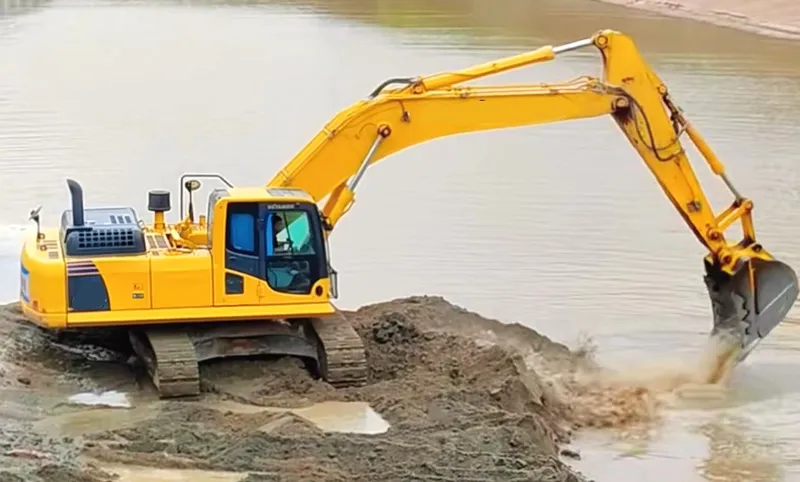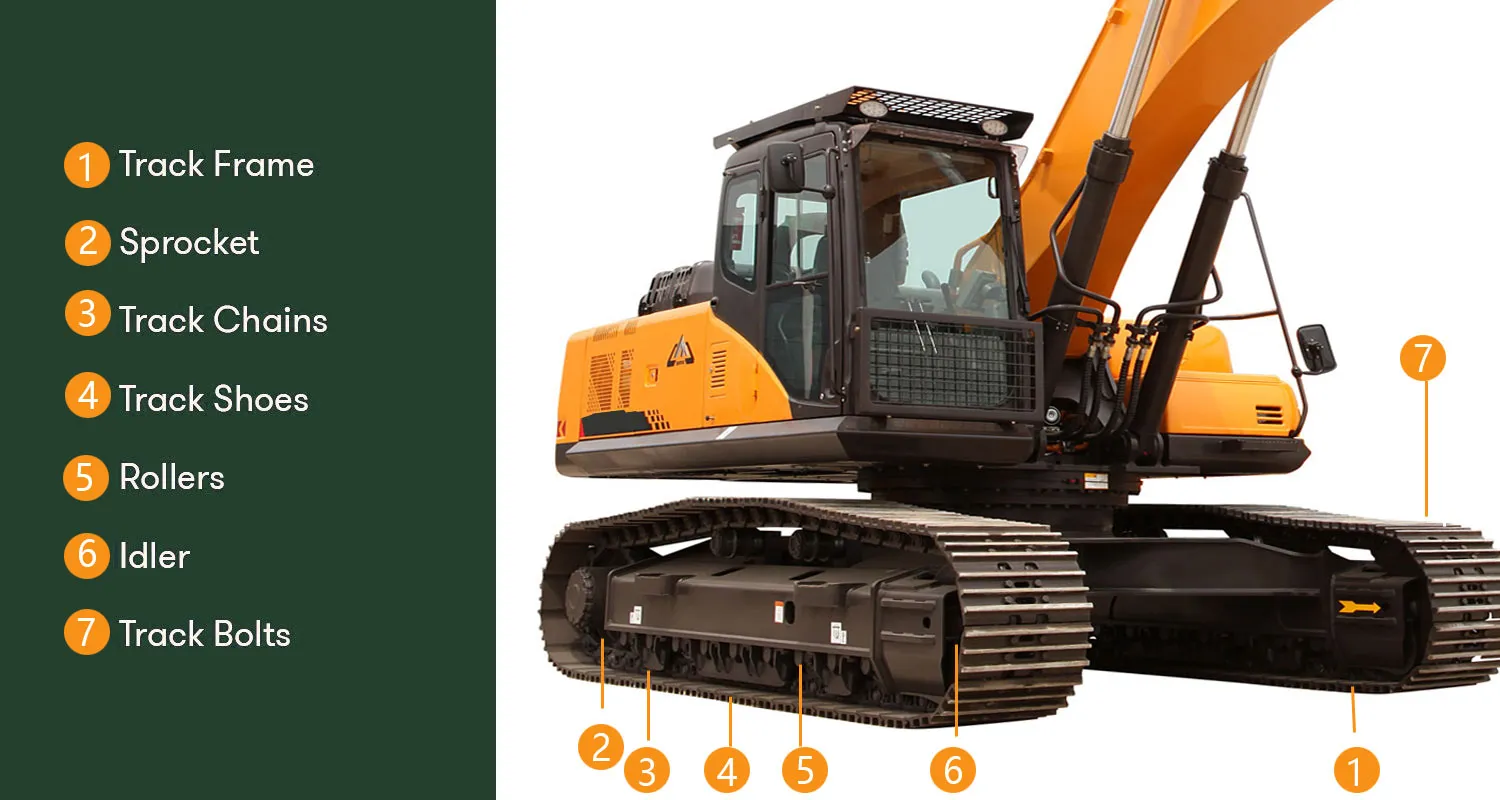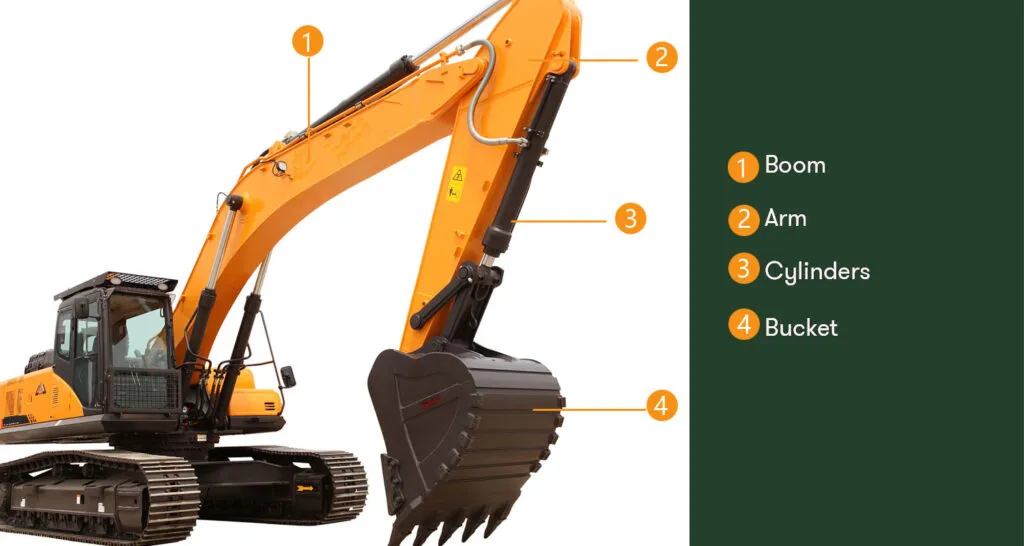
If you’re learning how to use an excavator, understanding its various elements will help you succeed at any job. Excavator parts are essential to grasp, as knowing them thoroughly will ensure you can operate the machine effectively and maintain it properly. So, what are the parts of an excavator? While they can differ slightly between models and manufacturers, you’ll find the same basic components in any excavator, whether you’re working with a mini excavator or a skid steer. This consistency across different types and sizes of excavators makes it easier to transfer your knowledge from one model to another.
When it comes to understanding all the excavator parts, they can easily be broken down into three main sections: the undercarriage, cab, and arm/boom. Each section plays a critical role in the overall functionality and performance of the excavator. The undercarriage supports the machine’s weight and provides mobility, the cab houses the operator and controls, and the arm/boom performs the digging and lifting tasks. Let’s uncover the parts of an excavator and their functions to give you a comprehensive overview of how these powerful machines work and how each part contributes to their operation. By familiarizing yourself with these excavator parts, you’ll be better equipped to handle the machine, troubleshoot issues, and perform routine maintenance.
The excavator undercarriage is the bottom structure of the excavator that contains various moving parts. This section is a crucial component of the excavator as it supports and drives the machine’s movement. The undercarriage includes tracks, rollers, drive wheels, and tensioning devices, all working together to ensure the excavator operates smoothly on different terrains. Whether on rugged construction sites or in muddy environments, the design of the undercarriage provides stability and durability, thus improving work efficiency and safety. Maintenance and inspection of the undercarriage are also very important; regular upkeep can extend the excavator’s lifespan and ensure it operates normally under various conditions.
Excavator tracks are essential components that enable the machine to traverse various terrains. Typically made with steel-reinforced rubber, these tracks provide the necessary grip and durability to move the excavator efficiently. The robust construction ensures that the tracks can withstand the heavy loads and harsh conditions often encountered on job sites. While some excavators are equipped with wheels and function similarly, tracks offer superior stability and traction, making them indispensable for tasks that require precise maneuvering and stability. The choice between tracks and wheels often depends on the specific requirements of the job, but tracks are generally favored for their rugged reliability and performance.
The track frame is a critical part of the excavator’s undercarriage, serving as the attachment point for the tracks. Functioning similarly to axles in wheeled vehicles, the track frame provides the necessary support and alignment for the tracks, ensuring smooth and efficient movement. This component is designed to handle the immense stresses and loads during excavation work, contributing significantly to the machine’s overall stability. Proper maintenance of the track frame is crucial for the longevity and performance of the excavator, as any misalignment or damage can lead to operational inefficiencies. The track frame is, therefore, a key element in the structural integrity of excavator parts.
Track pads are indispensable excavator parts designed to enhance the machine’s performance by mitigating excess noise, vibration, and surface damage. These pads are affixed to the track shoes and play a crucial role in providing better traction during operation. By absorbing shocks and minimizing the impact on the ground, track pads improve operator comfort and reduce wear and tear on the tracks and undercarriage. This is particularly beneficial in sensitive environments or urban areas where noise reduction and minimal ground disturbance are essential. Regular inspection and maintenance of track pads are vital to ensure their effectiveness, contributing to the excavator’s overall efficiency and longevity.
Track chains are fundamental components that allow an excavator to move efficiently across diverse terrains. Similar to bicycle chains in their construction, track chains are made up of interconnected flexible links that provide continuous movement. These chains are designed to handle heavy loads and resist wear, ensuring the excavator operates smoothly under various conditions. The durability and flexibility of track chains make them essential for maintaining the machine’s mobility and stability. Regular maintenance and proper lubrication of track chains are crucial to prevent breakdowns and ensure the excavator remains a reliable piece of equipment on any job site.
Track shoes are the individual parts of the excavator tracks that dig into the ground and pull the machine along. These components are designed to provide maximum traction and stability, enabling the excavator to perform effectively on different surfaces. Track shoes are made from durable materials to withstand harsh conditions and heavy usage, ensuring they do not wear out quickly. By maintaining a strong grip on the ground, track shoes contribute to the excavator’s overall efficiency and performance. Proper care and timely replacement of worn-out track shoes are essential to keep the excavator running smoothly and effectively.
Track bolts are the fasteners that link each track shoe together to form the entire track system. These bolts play a crucial role in maintaining the integrity and functionality of the track assembly. By securely connecting the track shoes, track bolts ensure that the tracks can handle the stresses and loads encountered during excavation work. Regular inspection and tightening of track bolts are necessary to prevent loosening and potential failures. The reliability of track bolts directly impacts the performance and safety of the excavator, making them vital components in the overall operation of the machine.
Rock guards are protective excavator parts designed to shield the tracks from debris and stray objects. These guards attach to the tracks and act as barriers, preventing rocks and other materials from causing damage to the undercarriage. By keeping the tracks clear of obstructions, rock guards help maintain the smooth operation of the excavator and reduce the risk of breakdowns. They are particularly useful in rocky or debris-laden environments where the potential for damage is high. Regular inspection and maintenance of rock guards are essential to ensure they provide effective protection and prolong the lifespan of the excavator tracks.
Sprockets are key mechanisms within the excavator’s undercarriage that interact with the track chain links. Similar to bicycle sprockets, these components drive the track chains, propelling the machine forward. Sprockets are designed to handle substantial forces and provide consistent movement, ensuring the excavator operates smoothly. The condition of the sprockets is crucial for the overall performance of the machine, as worn or damaged sprockets can lead to inefficiencies and potential breakdowns. Regular inspection and timely replacement of sprockets are necessary to maintain the optimal functionality of the excavator parts.
Rollers are metal wheels located on the excavator’s undercarriage, responsible for aligning the track chains and facilitating their movement between the sprocket and idler. There are two sets of rollers: bottom rollers, which support the weight of the machine, and top rollers, which guide the track chains. These rollers play a vital role in ensuring the smooth operation of the tracks, reducing friction and wear. Proper maintenance and lubrication of rollers are essential to prevent operational issues and prolong the lifespan of the tracks and undercarriage. Rollers are indispensable components in the efficient functioning of excavator parts.
Idlers are large metal wheels within the excavator’s undercarriage that help guide the tracks and maintain their tension. Bigger than rollers, idlers are crucial for ensuring the smooth operation of the tracks. They work in conjunction with the rollers and sprockets to keep the tracks aligned and moving efficiently. Proper tensioning and maintenance of idlers are essential to prevent track derailment and ensure the excavator operates effectively. Idlers are key components that contribute to the overall stability and performance of the machine, making them vital in the assembly of excavator parts.

You might think of it as the house or the car body, but the cab is really the mission control of an excavator. This is where you sit to operate the machine and monitor all the essential functions. Depending on the model, the cab can often rotate a full 360 degrees, giving you a complete view of your surroundings for maximum visibility. Inside the cab, you’ll find your main control system, which can differ from model to model, as well as several other important components that help you manage the excavator’s operations smoothly.
The main controls of an excavator are like its mission control center and can vary depending on the machine. This is where you’ll find all the essential functions needed to operate the excavator efficiently. These controls include the basic operations, steering mechanisms, and various safety measures. Each set of controls is designed to ensure the operator can manage the excavator parts effectively, providing precise control over the machine’s movements and functions. From here, you can handle everything from adjusting the boom and arm to monitoring the engine’s performance, making it a crucial component of the excavator.
ROPS stands for “rollover protective structure,” which is a critical safety feature in excavators. This structure is designed to protect the operator in the event of a rollover, ensuring their safety. The ROPS is built to withstand significant impact and stress, making it an essential part of the excavator’s overall design. By providing a secure environment for the operator, the ROPS ensures that safety is a top priority, especially in challenging and potentially hazardous working conditions.
The counterweight is an essential excavator part that does exactly what its name implies—it counterbalances the excavator during digging operations. This component provides necessary leverage and stability, preventing the excavator from tipping over when moving heavy loads. Properly calibrated counterweights are crucial for maintaining the machine’s balance and ensuring safe operation. By counteracting the weight of the arm and bucket, the counterweight helps maintain the excavator’s center of gravity, making it a vital element in the overall stability of the machine.
Often referred to as the heart of the excavator, the engine is typically housed near the cab for easy access during maintenance. It is usually powered by diesel fuel and is responsible for generating the power needed to operate various excavator parts. The engine’s performance directly impacts the efficiency and effectiveness of the machine. Regular maintenance of the engine is crucial to ensure it operates smoothly and reliably, providing the necessary power to drive hydraulic systems and other essential components of the excavator.
Hydraulic fluid tanks are crucial components in many excavators, as these machines often rely on hydraulic mechanisms for their operation. These tanks are typically housed within the cab or near it, making them easily accessible for maintenance and refilling. The hydraulic fluid stored in these tanks is used to power various excavator parts, including the boom, arm, and bucket. Maintaining the hydraulic fluid at optimal levels is essential for the smooth and efficient functioning of the excavator’s hydraulic systems.
The fuel tank is exactly what it sounds like—a tank where the excavator’s fuel is stored. Most excavators use diesel fuel, which is stored in this tank to power the engine. The size and capacity of the fuel tank can vary depending on the machine’s model and intended use. Ensuring the fuel tank is adequately filled and properly maintained is crucial for the continuous operation of the excavator. Without a reliable fuel supply, the engine and other excavator parts cannot function effectively.
The main control valve is a critical component that connects the engine to the hydraulic mechanisms of the excavator. It controls oil pressure and directs the flow of hydraulic fluid to various parts of the machine. This valve is essential for powering hydraulic devices such as the arm and boom. By regulating the hydraulic pressure, the main control valve ensures that these excavator parts operate smoothly and efficiently, allowing for precise movements and control during digging and other tasks.

Finally, on to the digging mechanism itself. The boom and arm, as crucial excavator parts, work together to do the actual earthmoving work.
The boom is a fundamental excavator part attached to the cab itself, serving as the front section of the machine. It holds the arm and plays a crucial role in the digging mechanism. The boom provides the necessary reach and lifting capability, allowing the excavator to perform various earthmoving tasks. Its sturdy construction ensures it can handle heavy loads and withstand the stresses of operation, making it an indispensable component of the excavator’s overall functionality.
Often referred to as the dipper or stick, the excavator arm is attached to the boom and holds the bucket. The arm works in conjunction with the boom to manipulate the bucket and position it correctly for digging and lifting operations. This excavator part is designed for maximum reach and flexibility, enabling the machine to perform a wide range of tasks. By coordinating the movements of the arm and boom, the operator can achieve precise control over the bucket, enhancing the excavator’s efficiency and versatility.
The bucket is the digging tool at the end of the arm, responsible for all your earthmoving needs. It comes in various shapes and sizes, depending on the specific task at hand. The bucket’s design and construction allow it to scoop, lift, and move materials efficiently. As one of the most visible and essential excavator parts, the bucket’s performance directly impacts the machine’s overall productivity. Regular maintenance and proper selection of the bucket are crucial for optimizing the excavator’s capabilities and ensuring successful completion of tasks.
Excavators typically feature three types of cylinders: boom, arm, and bucket cylinders. These cylinders are crucial components that connect different sections of the excavator and are responsible for their articulation. For instance, the bucket cylinder connects the arm to the bucket and enables the movement of the bucket back and forth. Each cylinder plays a vital role in ensuring smooth and precise movements of the excavator parts, allowing for efficient digging and lifting operations.
Excavators offer a variety of attachments to enhance their versatility and adapt to different project needs. These attachments can be added depending on the specific requirements of your task. Some common excavator equipment attachments include:
These attachments expand the capabilities of your excavator, making it a multi-functional machine suitable for various types of work.

Here are some of the most common queries about the parts of an excavator.
The exact number of parts in an excavator can vary depending on the specific model and type. However, there are generally 22 key parts that are most commonly found in excavators, including the boom, arm, bucket, engine, and hydraulic fluid tanks, among others.
The end of an excavator is known as the bucket. This essential component is used to dig into the earth, scoop up materials, and perform various other earthmoving tasks. The bucket is attached to the arm and is crucial for the excavator’s primary function.
The swing bearing allows the upper part of the excavator to rotate 360 degrees around the undercarriage, enabling smooth and efficient movement for tasks like digging and loading.
There are seven main types of excavators, each designed for different kinds of projects and tasks. These include standard excavators, mini excavators, long-reach excavators, dragline excavators, suction excavators, skid steer excavators, and hydraulic shovels. Each type offers unique features and capabilities to suit various construction and excavation needs.
Now that you know the basic excavator parts, you’ll be better prepared to operate the best machine for your project. Consider renting an excavator as a cost-effective option for your next job!